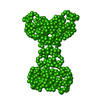[English] 日本語
 Yorodumi
Yorodumi- SASDC66: YtvA (lit/active state) (YtvA (pfyP - Blue light photoreceptor - ... -
+ Open data
Open data
- Basic information
Basic information
| Entry | Database: SASBDB / ID: SASDC66 |
|---|---|
 Sample Sample | YtvA (lit/active state)
|
| Function / homology |  Function and homology information Function and homology information |
| Biological species |   Escherichia coli (E. coli) Escherichia coli (E. coli) |
 Citation Citation |  Journal: J Mol Biol / Year: 2010 Journal: J Mol Biol / Year: 2010Title: The switch that does not flip: the blue-light receptor YtvA from Bacillus subtilis adopts an elongated dimer conformation independent of the activation state as revealed by a combined AUC and SAXS study. Authors: Marcel Jurk / Matthias Dorn / Alexey Kikhney / Dmitri Svergun / Wolfgang Gärtner / Peter Schmieder /  Abstract: Photoreceptors play an important role in plants and bacteria by converting extracellular stimuli into intracellular signals. One distinct class are the blue-light-sensitive phototropins harboring a ...Photoreceptors play an important role in plants and bacteria by converting extracellular stimuli into intracellular signals. One distinct class are the blue-light-sensitive phototropins harboring a light-oxygen-voltage (LOV) domain coupled to various effector domains. Photon absorption by the chromophore within the LOV domain results in an activation of the output domain via mechanisms that are hitherto not well understood. The photoreceptor YtvA from Bacillus subtilis is a bacterial analog of phototropins, consists of an LOV and a sulfate transporter/anti-sigma factor antagonist domain, and is involved in the response of the bacterium to environmental stress. We present here analytical ultracentrifugation studies and small-angle X-ray scattering experiments, showing that YtvA is a dimer. On the basis of these results, we present a low-resolution model of the dimer in the dark and the lit state of the protein. In addition, we show that YtvA does not change its oligomerization state or its overall shape upon light activation. |
- Structure visualization
Structure visualization
| Structure viewer | Molecule:  Molmil Molmil Jmol/JSmol Jmol/JSmol |
|---|
- Downloads & links
Downloads & links
-Data source
| SASBDB page |  SASDC66 SASDC66 |
|---|
-Related structure data
| Related structure data | C: citing same article ( |
|---|---|
| Similar structure data |
- External links
External links
| Related items in Molecule of the Month |
|---|
-Models
| Model #1445 |  Type: dummy / Radius of dummy atoms: 1.90 A / Symmetry  : P2 / Chi-square value: 9.07 : P2 / Chi-square value: 9.07 Search similar-shape structures of this assembly by Omokage search (details) Search similar-shape structures of this assembly by Omokage search (details) |
|---|---|
| Model #1444 |  Type: dummy / Radius of dummy atoms: 2.20 A / Symmetry  : P2 / Chi-square value: 7.896 : P2 / Chi-square value: 7.896 Search similar-shape structures of this assembly by Omokage search (details) Search similar-shape structures of this assembly by Omokage search (details) |
| Model #1446 |  Type: dummy / Radius of dummy atoms: 3.25 A / Chi-square value: 7.896  Search similar-shape structures of this assembly by Omokage search (details) Search similar-shape structures of this assembly by Omokage search (details) |
- Sample
Sample
 Sample Sample | Name: YtvA (lit/active state) / Specimen concentration: 1.70-11.00 |
|---|---|
| Buffer | Name: PBS + 5 mM DTT / pH: 7.4 Comment: 10 mM phosphate buffer; 2.7 mM KCl; 137 mM NaCl; 5 mM DTT |
| Entity #731 | Name: YtvA / Type: protein Description: YtvA (pfyP - Blue light photoreceptor - Bacillus subtilis (strain 168) Formula weight: 29.12 / Num. of mol.: 2 / Source: Escherichia coli / References: UniProt: O34627 Sequence: GASFQSFGIP GQLEVIKKAL DHVRVGVVIT DPALEDNPIV YVNQGFVQMT GYETEEILGK NCRFLQGKHT DPAEVDNIRT ALQNKEPVTV QIQNYKKDGT MFWNELNIDP MEIEDKTYFV GIQNDITKQK EYEKLLEDSL TEITALSTPI VPIRNGISAL PLVGNLTEER ...Sequence: GASFQSFGIP GQLEVIKKAL DHVRVGVVIT DPALEDNPIV YVNQGFVQMT GYETEEILGK NCRFLQGKHT DPAEVDNIRT ALQNKEPVTV QIQNYKKDGT MFWNELNIDP MEIEDKTYFV GIQNDITKQK EYEKLLEDSL TEITALSTPI VPIRNGISAL PLVGNLTEER FNSIVCTLTN ILSTSKDDYL IIDLSGLAQV NEQTADQIFK LSHLLKLTGT ELIITGIKPE LAMKMNKLDA NFSSLKTYSN VKDAVKVLPI M |
-Experimental information
| Beam | Instrument name:  DORIS III X33 DORIS III X33  / City: Hamburg / 国: Germany / City: Hamburg / 国: Germany  / Shape / Shape : 0.6 / Type of source: X-ray synchrotron : 0.6 / Type of source: X-ray synchrotron Synchrotron / Wavelength: 0.15 Å / Dist. spec. to detc.: 2.7 mm Synchrotron / Wavelength: 0.15 Å / Dist. spec. to detc.: 2.7 mm | |||||||||||||||||||||||||||||||||
|---|---|---|---|---|---|---|---|---|---|---|---|---|---|---|---|---|---|---|---|---|---|---|---|---|---|---|---|---|---|---|---|---|---|---|
| Detector | Name: Pilatus 1M-W / Pixsize x: 0.172 mm | |||||||||||||||||||||||||||||||||
| Scan |
| |||||||||||||||||||||||||||||||||
| Distance distribution function P(R) |
| |||||||||||||||||||||||||||||||||
| Result |
|
 Movie
Movie Controller
Controller













